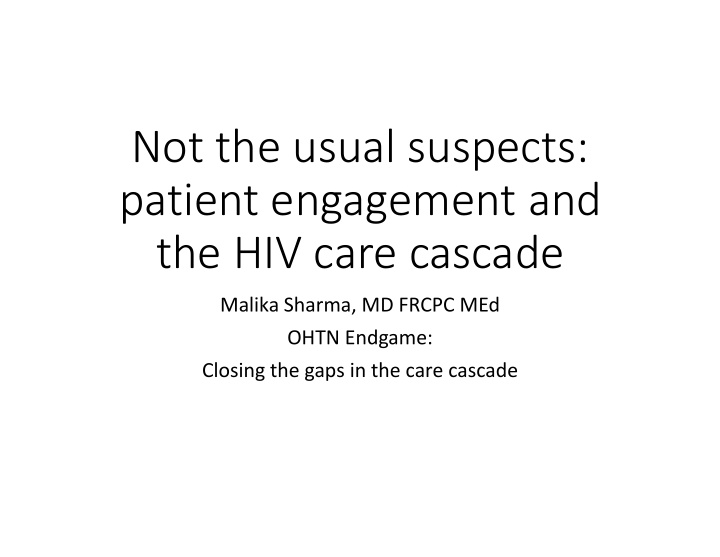



Not the usual suspects: patient engagement and the HIV care cascade Malika Sharma, MD FRCPC MEd OHTN Endgame: Closing the gaps in the care cascade
Disclosures • Currently funded by the CIHR CTN/CANFAR Postdoctoral fellowship • Previously funding by the University of Toronto Clinician Educator Training Program
Outline 1. Synthesize existing data on the HIV cascade of care & gaps for particular groups 2. Consider patient‐centered elements of the cascade 3. Discuss patient engagement as a means of humanizing the cascade
The Care Cascade
ART is not enough Timing of care Individual & Patient level outcomes Access to care
The HIV Care Cascade Mugavero 2013 Nosyk 2015
Calculating the Cascade Medland et al 2015
The cascade in context: Incarceration Iroh et al 2015
Cascade in Context: Youth Zanoni and Mayer 2014
Cascade in Context: Maternal Health • Transitioning care pre/peri/postpartum • Loss of focus on women’s health needs in the context of PMTCT • Pregnancy may preclude adequate time for assessment and drug readiness • Failure to include male partners • Confidentiality, stigma Colvin et al 2014
Cascade in Context: Commercial Sex Workers
The Care Cascade: Patient‐centered Solutions?
Qualitative data: much to teach us
• Examples: • Rural & remote: Telehealth • Women: settlement & interpretation services • Indigenous: telehealth, local availability • Food security
www.ohtn.on.ca/insideandout/assets/docs/inside‐and‐out‐conference‐backgrounder.pdf
Transitioning from Adolescent to Adult Care in HIV • Multidisciplinary team approach • Mutually developed culturally appropriate transition planning before the transition takes place • Education of adolescents for greater autonomy • Patient’s transition readiness (including knowledge and skills) using checklists and workbooks • Formal written transition policies • Registries for monitoring and evaluation of transition OHTN RAPID RESPONSE SERVICE | #96, JULY 2015
Patient Engagement
Engagement in care is only one way of talking about patient engagement
Patients are being engaged by hospitals, policymakers, and educators
Not all patient engagement is created equal
Involving PHAs in the HIV Cascade
Conclusion • The cascade of care has largely been defined in ways that are mostly data‐ and expert‐driven • Gaps in the cascade exist for several important populations • Identifying non‐traditional and non‐hierarchical sources of expertise can help close gaps in the cascade and help make it a meaningful, relevant, and a potential tool for patient empowerment.
Recommend
More recommend